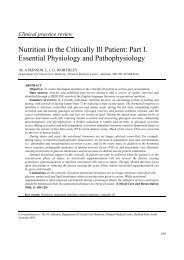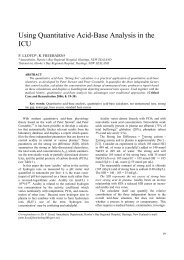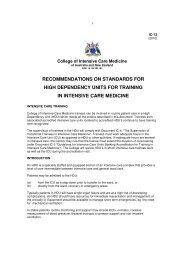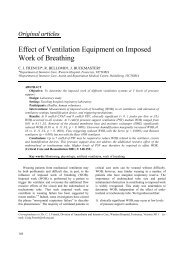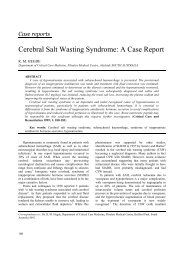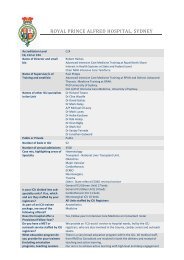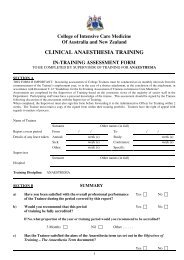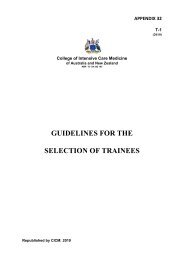Basic sciences review
Basic sciences review
Basic sciences review
Create successful ePaper yourself
Turn your PDF publications into a flip-book with our unique Google optimized e-Paper software.
<strong>Basic</strong> <strong>sciences</strong> <strong>review</strong><br />
Acid-Base Balance: Part I. Physiology<br />
J. McNAMARA, L. I. G. WORTHLEY<br />
Department of Critical Care Medicine, Flinders Medical Centre, Adelaide, SOUTH AUSTRALIA<br />
ABSTRACT<br />
Objective: To <strong>review</strong> the normal human acid-base physiology and the pathophysiology and management<br />
of acid-base disturbances in a two-part presentation.<br />
Data sources: Articles and published peer-<strong>review</strong> abstracts and a <strong>review</strong> of studies reported from 1990<br />
to 2000 and identified through a MEDLINE search of the English language literature on acid-base<br />
balance.<br />
Summary of <strong>review</strong>: In a healthy individual the extracellular fluid pH change following addition of a<br />
metabolic acid or base, is modified initially by the body’s buffers. Subsequent respiratory compensation, by<br />
excretion or retention of CO2, modifies this change before metabolism of the organic acid or renal<br />
excretion of the acid or alkali returns the plasma bicarbonate to normal. A primary respiratory acid-base<br />
change is modified initially by cellular buffers, with renal compensatory mechanisms adjusting slowly to<br />
this change. However, correction of the respiratory pH disorder only occurs with correction of the primary<br />
disease process.<br />
Conclusions: In man the acid-base balance is maintained and regulated by the renal and respiratory<br />
systems, which modify the extracellular fluid pH by changing the bicarbonate pair (HCO3 - and PCO2); all<br />
other body buffer systems adjust to the alterations in this pair. (Critical Care and Resuscitation 2001; 3:<br />
181-187)<br />
Key words: Acid-base balance, metabolic acidosis, metabolic alkalosis<br />
By affecting the charge on reactive groups of<br />
enzymes within the extracellular and intracellular fluids<br />
of the living organism, chemical reactions are influenced<br />
by the prevailing pH. 1 Despite the abundance of<br />
hydrogen in body fluids, the concentration or chemical<br />
activity of the H + ion (or hydronium ion H3O + ) is<br />
remarkably small and constant. This is largely due to the<br />
presence of buffer systems which allow for a rapid<br />
turnover of protons to take place with minimal alteration<br />
pH. Is the negative logarithm of the H + ion activity<br />
(Ha + ), which is equal to the H + ion concentration when<br />
the activity coefficient is unity. The pH is measured<br />
using a glass-membrane electrode porous only to H +<br />
ions. A transmembrane potential develops which is<br />
proportional to the log of the H + ion activity (Ha + ). This<br />
potential is compared with the potential recorded using<br />
the glass electrode and a standard solution of selected<br />
pH value.<br />
in H + ion activity. Within the physiological range of pH values in man,<br />
DEFINITIONS<br />
In general, the definitions suggested by the Ad Hoc<br />
Committee of the New York Academy of Sciences have<br />
been adopted. 2<br />
the H + ion activity coefficient is unity, therefore the<br />
measurement of H + provides an accurate and practical<br />
scale of acidity and alkalinity, when compared with its<br />
logarithmic counterpart of pH. 3 For example, it allows<br />
one to use the Henderson equation to assess clearly the<br />
Correspondence to: Dr. L. I. G. Worthley, Department of Critical Care Medicine, Flinders Medical Centre, Bedford Park, South<br />
Australia 5042 (e-mail: lindsay.worthley@flinders.edu.au)<br />
181
J. McNAMARA, ET AL Critical Care and Resuscitation 2001; 3: 181-187<br />
acid-base consequences of alteration in the PCO2 and<br />
HCO3 - values: 4<br />
Buffer. A solution containing substances that have<br />
the ability to minimise changes in the pH when an acid<br />
or base is added to it.<br />
[H + ] = K x CO2 pKa. The negative logarithm of the dissociation<br />
[HCO3 constant. If it describes a buffer system, then it is<br />
numerically equal to the pH of the system when the acid<br />
and its anion are present in equal concentrations.<br />
- ]<br />
The plasma concentration of the H + ion at a pH of<br />
7.4 is 40 nmol/L. Doubling or halving the H + concen- Strong ions. An analysis of acid-base chemistry has<br />
tration, reduces or increases the pH by log10 2, been proposed based on the law of electroneutrality in<br />
respectively (i.e. by approximately 0.3). Therefore, aqueous solutions, where the total number of cations<br />
must equal the total number of anions. 5,6 The central<br />
tenet to the analysis is that only the independent<br />
variables, which are the strong ions (e.g. sodium,<br />
potassium, calcium, magnesium, chloride and organic<br />
anions), PCO2 and the non-volatile weak acids (ATOT =<br />
HA + A - and in plasma is predominantly the albuminate<br />
ions), can change acid-base status, as they change the<br />
dependent variables of H + and HCO3 - pH H<br />
to maintain electrical<br />
neutrality.<br />
+ nmol/L<br />
6.8<br />
7.1<br />
7.4<br />
7.7<br />
160<br />
80<br />
40<br />
20<br />
The metabolic acid-base abnormality is characterised<br />
by calculating the strong-ion difference (or SID =<br />
[Na + + K + + Ca 2+ + Mg 2+ ] – [Cl - + lactate]), a value<br />
which is essentially equal to the sum of the bicarbonate<br />
and albuminate ions, 7 (i.e. HCO3 - = SID - A - ) and<br />
similar to the buffer base described by Singer and<br />
Hastings more than 50 years ago. 7-9<br />
Acid. A proton donor or H + ion donor.<br />
Base. A proton acceptor or H + ion acceptor.<br />
Acidaemia. Arterial blood pH less than 7.36 (H + ><br />
44 nmol/L).<br />
Alkalaemia. Arterial blood pH greater than 7.44 (H +<br />
< 36 nmol/L).<br />
Acidosis. An abnormal process or condition which<br />
tends to lower the arterial pH if there are no secondary<br />
changes in response to the primary disease process.<br />
This approach has not been helpful in clinical<br />
practice (e.g. it leads to the misconceptions that a saline<br />
induced dilution acidaemia is due to an increase in Cl -<br />
rather than a decrease in HCO3 - , or an elevated or<br />
reduced plasma albumin level may lead to metabolic<br />
acidosis and metabolic alkalosis, respectively). 10-12<br />
Alkalosis. An abnormal process or condition which<br />
tends to raise the arterial pH if there are no secondary<br />
changes in response to the primary disease process.<br />
A mixed disorder. Two or more primary acid-base<br />
abnormalities coexist.<br />
REGULATION OF pH [H + Compensation. Refers to normal body processes that<br />
tend to return the arterial pH to normal (e.g. respiratory<br />
or renal).<br />
] IN BODY FLUIDS<br />
In man, despite wide variations in dietary acid and<br />
base, there is no specific centre for H + ion regulation.<br />
The body’s respiratory and renal systems coordinate to<br />
regulate H + homeostasis by regulating HCO3 - and PCO2.<br />
The initial body defense against a change in pH is<br />
carried out by the body's buffer systems. 13<br />
Acid-base balance. Refers to the difference in<br />
quantity between input and output of acids and bases<br />
(Table 1).<br />
Table 1. Daily H + balance<br />
Input Output<br />
mmol/day mmol/day<br />
Volatile<br />
Carbon dioxide 13 000 Lungs 13000<br />
Lactate 1 500 Liver, Kidney 1500<br />
Nonvolatile<br />
Protein (SO4) 45 Titratable acid 30<br />
Phospholipid (PO4) 30 Ammonium 40<br />
Other 12<br />
182<br />
BODY BUFFERING<br />
Dilution<br />
If one compares the effect of adding the daily<br />
nonvolatile H + load (i.e. 70 mmol H + ) to a 70 kg man<br />
and to an equal volume of non-buffered water, at the<br />
same temperature and pH (e.g. table 2), it is clear that<br />
dilution is a poor defense against pH changes.<br />
Buffer systems<br />
These are present in the extracellular fluid (ECF)<br />
and intracellular fluid (ICF). Their effectiveness, or<br />
capacity, is proportional to the amount of buffer, the
Critical Care and Resuscitation 2001; 3: 181-187 J. McNAMARA, ET AL<br />
pKa of the buffer, the pH of the carrying solutions and<br />
whether the buffer operates as an open or closed system.<br />
Table 2. Effect of adding daily nonvolatile H + load to<br />
man and to an equivalent volume of nonbuffered<br />
water<br />
Water pH (H + nmol/L)<br />
volume (L) Before After<br />
70 kg man 42 7.4 (40) 7.39 (41)<br />
Water 42 7.4 (40) 2.78 (1 666 666)<br />
Buffer mechanisms<br />
Any chemical reaction reaching an equilibrium can<br />
be expressed by the law of mass action. In the case of a<br />
weak acid:<br />
HA [H + ] + [A - ] (1)<br />
at equilibrium the product of the concentrations of H +<br />
and A - is a constant fraction of the concentration of HA<br />
or:<br />
K = [H + ] [A - ] (2)<br />
[HA]<br />
The value of K at equilibrium is always the same and<br />
independent of the concentrations of the reactants that<br />
are present initially. With the addition of another acid<br />
(i.e H + donor) to the system, the ionisation of the weak<br />
acid HA is reduced (to keep K constant). If a base is<br />
added, the reduction in the H + ion concentration<br />
produces further ionisation of the acid, HA. Both reduce<br />
the change in H + ion concentration (pH).<br />
However, as the ionisation of a weak acid is small,<br />
only a small addition of H + can be tolerated before the<br />
pH falls. By supplementing the ion A - with the addition<br />
of a salt of a strong base (e.g. NaA), this acts as a<br />
reservoir of A - for combining with the added H + .<br />
Therefore, a buffer system can be produced by mixing<br />
a weak acid with the salt of that acid and a strong<br />
base. Equation (2) can be rearranged as:<br />
[H + ] = K x [HA] (3) Henderson equation<br />
[A - ]<br />
The negative log of equation (3) is:<br />
pH = pKa + log [A - ] (4) Henderson-Hasselbalch<br />
[HA] equation<br />
From equation (4) it can be seen that the pH of 1 L<br />
of a weak acid solution with a pKa of 7.0 which has a<br />
concentration of 5.5 mmol/L of [A - ] and 5.5 mmol/L of<br />
HA, is 7.0. If 0.5 mmol of a strong acid is added to this<br />
solution, [A - ] will combine with the free [H + ] to form<br />
HA (i.e the concentration of [A - ] will decrease to 5<br />
mmol/L and the concentration of HA will increase to 6<br />
mmol/L) and the pH will decrease to 6.92. If 4.5 mmol<br />
of a strong acid are added to the solution, the<br />
concentration of [A - ] will decrease to 1 mmol/L, the<br />
concentration of HA will increase to 10 mmol/L and the<br />
pH will fall to 6.0. However, addition of more acid<br />
reduces the pH dramatically (e.g. the addition of an<br />
extra 0.9 mmol of acid will decrease the pH to 5 and the<br />
addition of an extra 0.999 mmol of acid will decrease<br />
the pH to 3). So most (i.e. 80%) of the buffering occurs<br />
within + 1 pH unit of the pKa value of the buffer system<br />
(Fig. 1), which occurs when,<br />
Figure 1. Reaction curve for the buffer HA:[A - ] where pH = pKa + 2.<br />
(After Guyton AC. Textbook of medical physiology. 4 th Ed, WB<br />
Saunders & Co, Philadelphia. 1971).<br />
log [A - ] is + 1 i.e., BASE 10 or 1<br />
HA ACID 1 10<br />
The major body buffer systems involve bicarbonate,<br />
protein, haemoglobin and phosphate.<br />
Bicarbonate-carbonic acid buffer pair. The arterial<br />
H + ion activity can be represented by the Henderson<br />
equation:<br />
[H + ] = 24 x PaCO2<br />
[HCO3 - ]<br />
or the Henderson-Hasselbalch equation:<br />
pH = 6.1 + log [HCO3 - ]<br />
PaCO2 x 0.03<br />
Where:<br />
24 = the numerical value of the solubility<br />
coefficient of carbon dioxide and the<br />
dissociation constant of carbonic acid.<br />
PaCO2 = arterial blood partial pressure in mmHg<br />
[HCO3 - ] = arterial blood bicarbonate concentration in<br />
mmol/L<br />
[H + ] = arterial blood H + ion concentration in<br />
nmol/L<br />
183
J. McNAMARA, ET AL Critical Care and Resuscitation 2001; 3: 181-187<br />
0.03 = solubility coefficient of carbon dioxide<br />
6.1 = negative logarithm of the dissociation<br />
constant of carbonic acid<br />
This system is quantitatively the most important ECF<br />
buffer, and functions better as a physiological (or open)<br />
buffer than chemical (or closed) buffer. Its pKa is 6.1,<br />
therefore its chemical buffering capacity at a pH of 7.4<br />
is poor (see position x in figure 1).<br />
The benefit of an open, rather than closed, buffer<br />
system can be demonstrated if both systems are<br />
subjected to a pH change of 0.3 units by the addition of<br />
an acid. If one considers the Henderson-Hasselbalch<br />
equation under normal conditions, when pH 7.4, PaCO2<br />
40 mmHg, HCO3 - 24 mmol/L, then:<br />
7.4 = 6.1 + log 24<br />
1.2<br />
However, addition of an acid to decrease the pH by<br />
0.3 units, will produce different effects in the closed<br />
system when compared to the open system. For<br />
example,<br />
A closed buffer system An open buffer system<br />
7.1 = 6.1 + log 22.9 7.1 = 6.1 + log 12<br />
2.29 1.2<br />
In both systems the ratio of H2CO3 to HCO3 - remains<br />
constant. In the closed system the total amount of H2CO3<br />
and HCO3 - remains constant (i.e. 25.2 mmol/L). In the<br />
open system, the denominator only is kept constant at<br />
1.2 mmol/L, by increasing the ventilation and keeping<br />
the PaCO2 at 40 mmHg (40 x 0.03 = 1.2). The buffer<br />
anion in the closed system falls from 24 to 22.9 whereas<br />
in the open system it falls from 24 to 12, thereby<br />
buffering more H + .<br />
The bicarbonate/carbonic acid system also has the<br />
added advantage of a further carbon dioxide change<br />
with respiratory compensation, reducing even further the<br />
pH defect. These responses are shown, in stages, in<br />
figure 2.<br />
The utility of this buffer system can be fully<br />
appreciated when it is realised that it is ‘open ended’ for<br />
both the numerator and the denominator. The PaCO2 can<br />
be modified by a change in ventilation, and the HCO3 -<br />
concentration can be regulated by renal mechan-isms.<br />
All other buffer systems in the body adjust accordingly<br />
to alterations in this pair, an interrelationship<br />
which is termed the isohydric principle.<br />
Haemoglobin, protein and phosphate buffers.<br />
Proteins have a series of titratable groups within their<br />
molecular structure with the ability to buffer pH<br />
184<br />
changes. The buffering characteristic of haemoglobin is<br />
almost entirely dependent upon the imidazole group of<br />
histidine, which dissociates less when haemoglobin is in<br />
the oxygenated form compared with the deoxygenated<br />
form. Thus, deoxygenated blood is a better buffer than<br />
oxygenated blood; the haemoglobin molecule accommodates<br />
0.7 mmol of H + for each mmol of oxygen<br />
released, without any change in pH. As the respiratory<br />
quotient is normally 0.8, a slight reduction in pH usually<br />
occurs when blood travels from the arterial to the<br />
venous system.<br />
Figure 2. Bicarbonate buffer system in blood (in vitro) if acid were<br />
added at A to reduce plasma HCO3 - by 50%. The histograms<br />
represent buffering if it were to occur in 3 separate stages. Stage 1<br />
represents chemical buffering only, stage 2 represents the added effect<br />
of maintaining pCO2 constant, and stage 3 represents the<br />
compensatory reduction in pCO2 in response to the acid load. (After<br />
Gamble JL. Chemical anatomy, physiology and pathology of<br />
extracellular fluid. 6th Ed. Harvard University Press, Massachusetts<br />
1951).<br />
The haemoglobin buffer is an important one, as it is<br />
involved in handling the largest daily acid load of the<br />
body, i.e. carbonic acid. Gram for gram, plasma proteins<br />
have one-third the buffering capacity of haemoglobin;<br />
however, as haemoglobin has twice the concentration of<br />
plasma protein, it has six times the capacity to buffer H + .<br />
The phosphate buffer system has a pKa of 6.8 and so<br />
is a better chemical (or closed) buffer system than the<br />
bicarbonate buffer system. However, in plasma it has<br />
one-twentieth the concentration of bicarbonate, and also<br />
operates only as a closed system, so its capacity is far<br />
less than that of the bicarbonate-carbonic acid buffer. In<br />
the ICF and in urine, the phosphate buffer system<br />
assumes greater importance.<br />
Total Body Buffering<br />
The contributions of ICF and ECF buffers vary<br />
depending upon the nature, severity and duration of the
Critical Care and Resuscitation 2001; 3: 181-187 J. McNAMARA, ET AL<br />
acid or base disturbance. In dogs in which respiratory or<br />
metabolic acid-base defects were produced, the<br />
respiratory pH changes were buffered mainly by ICF<br />
buffers, whereas metabolic pH changes had a greater<br />
ECF buffering component (Figure 3). 14-16 Preferential<br />
utilisation of extracellular buffers occurs in the initial<br />
phase of a metabolic acidosis with the contribution of<br />
ICF buffers becoming greater as the acidosis increases<br />
in severity. 17<br />
Figure 3. Buffering contributions of the intracellular fluid (ICF) and<br />
extracellular fluid (ECF) with primary respiratory or metabolic acidbase<br />
changes. (After Pitts RF. Physiology of the kidney and body<br />
fluids 2 nd Ed. Year Book Medical Publishers, Chicago. 1968).<br />
Experiments using rat diaphragm and human<br />
leucocytes reveal that conditions simulating respiratory<br />
acidosis or alkalosis produce a greater ICF pH change<br />
than do conditions simulating metabolic acidosis or<br />
alkalosis. 18-20 Furthermore, when metabolic acidosis or<br />
alkalosis are simulated and appropriate respiratory<br />
compensatory (i.e. carbon dioxide) changes are also<br />
included, the ICF pH remains remarkably constant,<br />
suggesting that there is a greater in vivo tolerance to<br />
metabolic pH change than there is to respiratory pH<br />
change. 18,21,22 Although, studies in animals with severe<br />
respiratory acidosis (e.g. PCO2 values up to 200<br />
mmHg), the ICF pH is usually always greater than 6.8. 23<br />
RESPIRATORY RESPONSE<br />
It is clear when considering the Henderson equation<br />
[Equation (1)], that variations in PCO2 alter the pH. The<br />
effect is rapid and influences both the ICF and ECF.<br />
Arterial PCO2 varies inversely with alveolar ventilation<br />
and directly with carbon dioxide production. Normal<br />
carbon dioxide production is 13,000 mmol per day; if<br />
pulmonary ventilation ceased in man for 20 min, PaCO2<br />
would rise to 110 mmHg (13.3 kPa) and pH would fall<br />
to 7.03. If renal function ceased for a similar period, no<br />
change in arterial pH would occur.<br />
Regulation of ventilation involves a complex<br />
interplay between mechanical and chemical stimuli. Any<br />
change in arterial HCO3 - , PCO2, pH, PO2 or stimuli from<br />
pulmonary mechanoreceptors alter ventilation and thus<br />
PaCO2 and pH. The respiratory response to a metabolic<br />
pH change follows peripheral chemoreceptor<br />
stimulation, and provides the compensatory response to<br />
metabolic pH change.<br />
RENAL RESPONSE<br />
This determines the final outcome to the acid or base<br />
load, by altering the denominator of the Henderson<br />
equation (i.e. [HCO3 - ]). The response is slow and the<br />
maximum excretory capacity of 300 mmol H + can only<br />
be reached after 7-10 days. 24<br />
Unlike all other ions, HCO3 - has no permanence. It<br />
may be generated from carbon dioxide and water or lost<br />
with carbon dioxide excretion. The accompanying H +<br />
generated or lost is dealt with by the body’s buffers. The<br />
kidney uses the HCO3 - ion for alkali reserve and as an<br />
anion for sodium reabsorption or excretion when<br />
maintaining the ECF volume; the lungs use the HCO3 -<br />
ion for carbon dioxide transport and excretion.<br />
Renal regulation of H + balance is due to reabsorption<br />
or excretion of filtered HCO3 - , excretion of titratable<br />
acidity (TA) and excretion of ammonia. Tubular H +<br />
secretion usually involves Na + reabsorption, maintaining<br />
electrical neutrality.<br />
Reabsorption (reclaiming) filtered HCO3 -<br />
About 85-90% of the filtered HCO3 - is reclaimed by<br />
the proximal tubule. Further reabsorption occurs in the<br />
distal nephron, with the luminal fluid being free of<br />
HCO3 - at a luminal pH of 6.2. 25 The amount of HCO3 -<br />
185
J. McNAMARA, ET AL Critical Care and Resuscitation 2001; 3: 181-187<br />
reaching the distal nephron is influenced by the filtered<br />
load of HCO3 - (i.e. with a metabolic acidosis, the total<br />
proximal H + secretion is less than normal) and the<br />
functional ECF volume. 26 The mechanism of proximal<br />
tubular HCO3 - reabsorption relies upon H + secretion.<br />
Cellular carbonic anhydrase (CA) supplies H + for the<br />
hydrogen pump and the brush border CA facilitates the<br />
combination of HCO3 - with H + . In the absence of the<br />
brush border carbonic anhydrase, a disequilibrium pH of<br />
0.85 - 1.0 occurs, and proximal H + secretion is inhibited.<br />
Formation of titratable acidity<br />
At a pH of 7.4, four fifths (80%) of the circulating<br />
phosphate is in the monohydrogen form and one fifth<br />
(20%) is in the dihydrogen form. The majority of the<br />
urinary titratable acidity (TA) is formed with the<br />
conversion of monohydrogen phosphate to dihydrogen<br />
phosphate, which occurs throughout the nephron. 25 The<br />
pKa of this system is 6.8, and at maximum urinary<br />
acidity (i.e. pH 4.5) almost all (99%) of the filtered<br />
phosphate is in the dihydrogen form. At this urinary pH,<br />
74% of the filtered creatinine (pKa 4.97) and 92% of the<br />
uric acid (pKa 5.8) are in the nonionised mode, and may<br />
account for 25% of the urinary TA at maximum urinary<br />
acidity.<br />
Normally, 20 - 30 mmol of H + /day are excreted as<br />
TA, and this is proportional to the amount of buffer<br />
excreted, the pKa of the buffer, and the pH of the urine.<br />
In diabetic ketoacidosis the rate of excretion of unionised<br />
betahydroxybutyrate (pKa 4.8) with maximum<br />
urinary acidity is 66%; so, in this condition it forms a<br />
large component (e.g. up to 250 mmol H + /day) of<br />
urinary TA. Acetoacetic acid has a pKa value of 3.8 and<br />
therefore only 17% is excreted at maximum urinary<br />
acidity, although as the beta-hydroxybutyrate:acetoacetate<br />
ratio is usually 3:1 (which may increase up to 9:1<br />
with reduced redox states) almost all of the urinary<br />
ketone excretion is in the form of betahydroxybutyric<br />
acid. Only 20% of lactic acid (pKa 3.9) remains in the<br />
nonionised state at maximum urinary acidity, therefore<br />
excretion of unionised lactic acid in lactic acidosis is<br />
also low.<br />
Normally, urinary excretion of phosphate is<br />
determined by the need to maintain phosphate balance<br />
rather than acid-base homeostasis. Thus TA appears to<br />
play a supportive, rather than an active, role in H +<br />
balance.<br />
Formation of ammonia<br />
The major site for ammonia (NH3) production is in<br />
the proximal convoluted tubule epithelium although it<br />
can be formed in tubular epithelia throughout the<br />
nephron. 27 Deamidation and deamination of glutamine<br />
accounts for 60% of the urinary NH3 whereas 30 - 35%<br />
186<br />
comes from free arterial NH3. The NH3 diffuses into the<br />
renal tubular lumen where it binds a H + ion to form a<br />
non diffusible ammonium ion (NH4 + ) which is subsequently<br />
excreted. 28 This process permits Na + /H + exchange<br />
to occur without further change in urinary pH, although<br />
an acidic urine allows a greater sink into which free NH3<br />
can diffuse and is therefore one of the determinants of<br />
urinary NH4 + excretion.<br />
Renal tubular synthesis of NH3 is coupled to renal<br />
gluconeogenesis which in turn is attuned to the body’s<br />
acid-base requirements. Systemic acidosis, hypokalaemia<br />
and mineralocorticoids increase ammonia production.<br />
27 Normally 30 - 50 mmol of H + /day are excreted as<br />
NH4 + , which may increase to 300 mmol/day in severe<br />
acidosis.<br />
Mechanisms of proximal and distal H + secretion<br />
Proximal H + secretion<br />
This is a low-gradient (minimal luminal pH achievable<br />
is 7.0), high-capacity (its H + secretion is responsible<br />
for reabsorbing most of the filtered HCO3 - , i.e. 4000<br />
- 5000 mmol/day) system. The proximal H + secretion is<br />
increased with hypokalaemia, hypercapnia, increased<br />
luminal HCO3 - , increased tubular Na + reabsorption, the<br />
presence of nonreabsorbable anions (e.g. SO4 2- , NO3 - ,<br />
penicillin anion) and increase in carbonic anhydrase<br />
activity. In the presence of a functional ECF depletion,<br />
nonreabsorbable anion or metabolic alkalosis, the<br />
Na + /H + exchange mechanism is exaggerated, maintaining<br />
the ECF volume at the expense of pH homeostasis.<br />
Thus the maximum HCO3 - reabsorption capacity of the<br />
kidney (i.e. Tm HCO3 - ) is not a fixed value and varies in<br />
response to the above factors. 26<br />
Distal H + secretion<br />
This is a high-gradient (minimal luminal pH achievable<br />
is 4.5), low-capacity (H + secretion ranges from 0 -<br />
300 mmol/day) system. Unlike the proximal tubule the<br />
distal nephron is influenced by mineralocorticoid<br />
activity. In hyperaldosteronism, distal Na + reabsorption<br />
and excretion of H + and K + are enhanced. In the<br />
presence of hypokalaemia, H + loss is augmented due to<br />
electroneutrality requirements for some of the distal Na +<br />
reabsorbed. In secondary hyperaldosteronism, the K +<br />
and H + losses may be less than in primary<br />
hyperaldosterone states, due to a reduction in distal<br />
luminal flow induced by avid proximal Na +<br />
reabsorption. Thus an increase in distal H + or K + urinary<br />
secretion may only become evident when distal Na +<br />
delivery is increased, for example with the use of<br />
diuretics or the administration of a sodium salt of a non<br />
reabsorbable anion.
Critical Care and Resuscitation 2001; 3: 181-187 J. McNAMARA, ET AL<br />
Received: 20 June 2001<br />
Accepted: 24 August 2001<br />
REFERENCES<br />
1. Relman AS. Metabolic consequences of acid-base<br />
disorders. Kidney Int 1972;1:347-359.<br />
2. Anderson OS, Astrup P, Bates RG, et al. Report of ad<br />
hoc committee on acid-base terminology. Ann NY Acad<br />
Sci 1966;133:251-253.<br />
3. Campbell EJM. RIpH. Lancet 1962;i:681-683.<br />
4. Henderson LJ. The theory of neutrality regulation in the<br />
animal organism. Amer J Physiol 1908;21:427-448.<br />
5. Stewart PA. Modern quantitative acid-base chemistry.<br />
Can J Physiol Pharmacol 1983;61:1444-1461.<br />
6. Fencl V, Leith DE. Stewart's quantitative acid-base<br />
chemistry: applications in biology and medicine. Respir<br />
Physiol 1993;91:1-16.<br />
7. Siggaard-Andersen O, Fogh-Andersen N. Base excess or<br />
buffer base (strong ion difference) as measure of a nonrespiratory<br />
acid-base disturbance. Acta Anaesthesiol<br />
Scand Suppl 1995;107:123-128.<br />
8. Singer RB, Hastings AB. An improved clinical method<br />
for the estimation of disturbances of the acid-base<br />
balance of human blood. Medicine (Baltimore)<br />
1948;27:223-242.<br />
9. Wooten EW. Analytic calculation of physiological acidbase<br />
parameters in plasma. J Appl Physiol 1999;86:326-<br />
334.<br />
10. Worthley LIG. Strong ion difference: a new paradigm or<br />
new clothes for the acid base emperor. Critical Care and<br />
Resuscitation 1999;1:211-214.<br />
11. Siggaard-Andersen O, Fogh-Andersen N. Base excess or<br />
buffer base (strong ion difference) as measure of a nonrespiratory<br />
acid-base disturbance. Acta Anaesthesiol<br />
Scand Suppl 1995;107:123-128.<br />
12. Asano S, Kato E, Yamauchi M, Ozawa Y, Iwasa M. The<br />
mechanism of acidosis caused by infusion of saline<br />
solution. Lancet. 1966; i: 1245-1246.<br />
13. Worthley LIG. Hydrogen ion metabolism. Anaesth<br />
Intens Care 1977;5:347-360.<br />
14. Giebisch G, Berger L, Pitts RF. The extrarenal response<br />
to acute acid base disturbances of respiratory origin. J<br />
Clin Invest 1955;34:231-245.<br />
15. Swan RC, Pitts RF. Neutralization of infused acid by<br />
nephrectomized dogs. J Clin Invest 1955;34:205-212.<br />
16. Swan RC, Axelrod DR, Seip M, Pitts RF. Distribution<br />
of sodium bicarbonate infused into nephrectomized<br />
dogs. J Clin Invest 1955;34:1795-1801.<br />
17. Schwartz WB, Orning KJ, Porter R. The internal<br />
distribution of hydrogen ions with varying degrees of<br />
metabolic acidosis. J Clin Invest 1957;36:373-382.<br />
18. Adler S, Roy A, Relman AS. Intracellular acid-base<br />
regulation, II The interaction between CO2 tension and<br />
the extracellular bicarbonate in the determination of<br />
muscle cell pH. J Clin Invest 1965;44:21-29.<br />
19. Relman AS. The participation of cells in disturbances of<br />
acid-base balance. Ann N Y Acad Sci 1966;133:160-<br />
171.<br />
20. Levin GE, Collinson P, Baron DN. The intracellular pH<br />
of human leucocytes in response to acid-base changes in<br />
vitro. Clin Sci 1976;50:293-299.<br />
21. Schwartz WB, Brackett NC Jr, Cohen JJ. The response<br />
of extracellular hydrogen ion concentration to graded<br />
degrees of chronic hypercapnia: the physiological limits<br />
of the defense of pH. J Clin Invest 1965;44:291-302.<br />
22. Adler S, Roy A, Relman AS. Intracellular acid-base<br />
regulation, I The response of muscle cells to changes in<br />
CO2 tension or extracellular bicarbonate concentration.<br />
J Clin Invest 1965;44:8-20.<br />
23 . Feihl F, Perret C. Permissive hypercapnia. How<br />
permissive should we be? Am J Resp Crit Care Med<br />
1994;150:1722-1737.<br />
24. Sartorius OW, Roemmelt JC, Pitts RF. The renal<br />
regulation of acid base balance in man: The nature of<br />
renal compensations in ammonium chloride acidosis. J<br />
Clin Invest 1949;28:423-439.<br />
25. Pitts RF. Physiology of the kidney and body fluids. 2nd<br />
Ed. Year Book Medical Publishers. Chicago 1968.<br />
26. Seldin DW, Rector FC. The generation and maintenance<br />
of metabolic alkalosis. Kidney Int 1972;1:306-321.<br />
27. Toto RD. Metabolic acid-base disorders. In Kokko JP,<br />
Tannen RL (eds). Fluids and Electrolytes. WB Saunders<br />
Co, Philadelphia, 1986, pp 229-304.<br />
28. Pitts RF. The role of ammonia production and excretion<br />
in regulation of acid base balance. N Engl J Med<br />
1971;284:32-38.<br />
187




